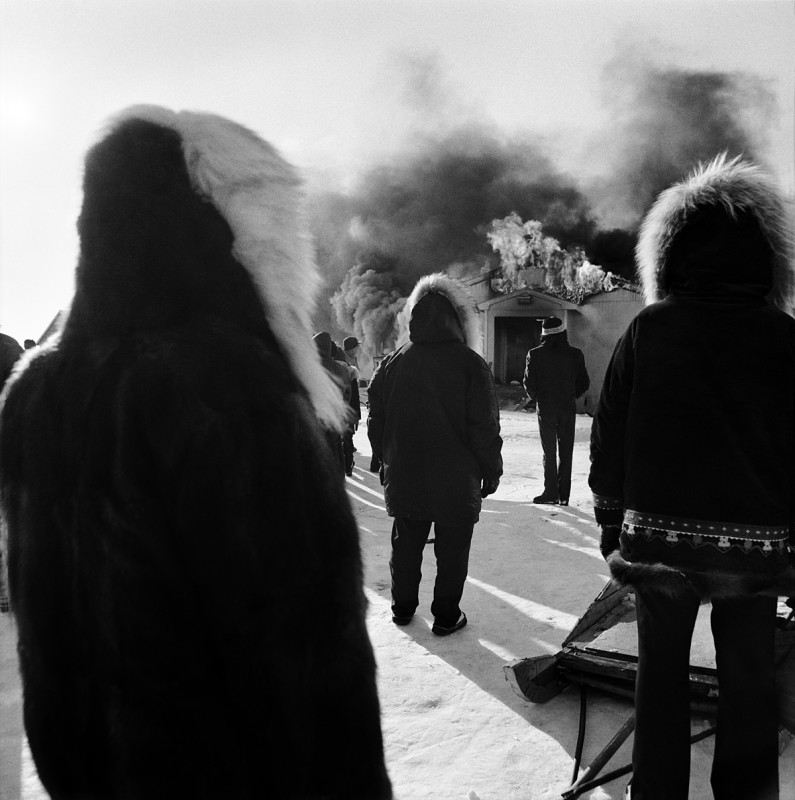
Watching a Building Burn
Three parka-clad men, their backs to the camera, stand on an ice–covered field. Their body language – what we can see of it – implies rest, perhaps resignation, as they watch a building burn. Minutes earlier, inside a Quaker church in the Alaskan Inuit village of Selawik, these same men heard screams of “fire!” Outside, there was nothing to be done. The burning building, a schoolhouse, contained the only running water in the village, and regardless, the blaze was too far-gone to be fought.
On that April day of 1974, I was part of the crowd watching the schoolhouse burn. I was also a photographer with one roll of film in my camera, eight exposures left, trying quickly to make sense of the moment. Instinctively, I used my lens to see the fire and smoke through the bodies of the men in front of me, the way someone in the crowd would see the fire, the way the men themselves might be experiencing this moment. My instincts were to break most of the rules being taught in photojournalism school at the time. No faces are evident. No action is depicted. People standing in front of my camera mostly obscure the event itself. Yet this same photograph manages to suggest something larger than the moment, hints at the Inuit’s relationship to their environment; implies their acceptance of the power of nature.
Between 1973 and 1978 I made five trips to Alaska, living cumulatively for over a year in several Inuit villages above the Arctic Circle along the Kobuk River as well as other villages on the Yukon-Kuskokwim Delta of the southern Bering Sea coast. I often arrived on a single engine weekly mail plane, and if visiting a village for the first time, would be greeted by a small group eager to see relatives who might be on the flight, or anxious to retrieve mail and supplies from the outside. Invariably someone would ask, “Why are you here?” When I said I was there to take pictures, a second question followed. “Where are you staying?” I would respond that I didn’t know. “Then stay with us.”
I learned that there was nothing naïve about the invitation. The Inuit were hospitable and trusting in this sense: they gave me time and a chance to prove myself to be a person they wanted to have around. And I wanted very much to be that person. I believe I became that person.
At the time, I was a few years out of college and beginning my second education. For one thing, I was learning the craft of photography, and starting to have control of the medium. I had studied Adams’s zone system for film exposure and development, and knew how to compact into visible detail the range of light in Alaska – from bright sun on snow to deep shadow on parkas – falling on my film. Still, I had quite a distance to go to master the medium technically.
Mostly what I had to offer was my eagerness to get to know the people and places I photographed. I hoped that my familiarity would be reflected in the pictures I made. I was shooting black–and–white film, some 35mm but primarily medium format, and storing my exposed rolls under my bed inside a red tin coffee can with a plastic top. But in another sense, I had to store the photographs in my mind, as I wouldn’t see any of my pictures until I returned to the “lower 48” and developed my film. So I often brought with me a couple of photographic books for inspiration, looking not so much to answer questions about technique, framing, or exposure, but to try to understand what a photographer’s work could tell me about how to get inside another world with a camera.
In 1975 one book I brought with me was Koudelka’s The Gypsies. Whether the Gypsies looked back at Koudelka with recognition, or ignored him entirely, I was enormously drawn to the implied intimacy of the pictures he made. Koudelka was absolutely present in his own pictures, yet his own likeness never appears. He made photographs full of life and also full of mystery.
Though I didn’t take on Koudelka’s high–contrast, wide–angle style, I did begin to understand from him how to get inside another world with a camera. In Alaska I came know people in a way that allowed me to participate in their lives. On each successive trip to the villages, I saw it was possible to immerse myself in a world and at the same time to observe it, to step back from the moment I was experiencing and take a photograph. I learned to make pictures – like those I’d seen in The Gypsies – pictures that hinted at more than I saw, more than I knew, more than we can ever know about another person, place or culture.
Alex Harris
Some of these photographs were first published in The Last and First Eskimos in 1978, and exhibited at the International Center of Photography in New York in that same year.

















































